-
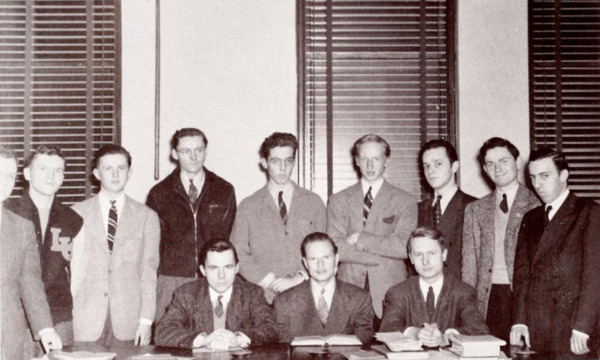
A group of students pose for a photograph both standing and seated at a table. These were members of the Rough Writers, a student organization founded in late 1940 for students interested in writing fiction and poetry to present their work and enter writing contests.
-

Photograph of Loyola New Staff from yearbook
-
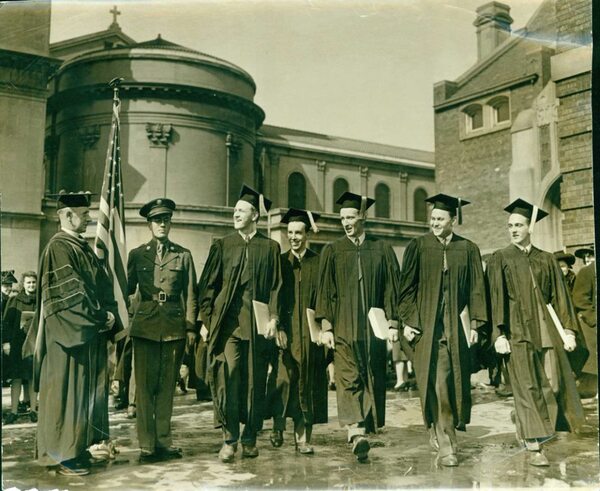
Black and white photograph of graduates from the accelerated medical program in 1943.
-
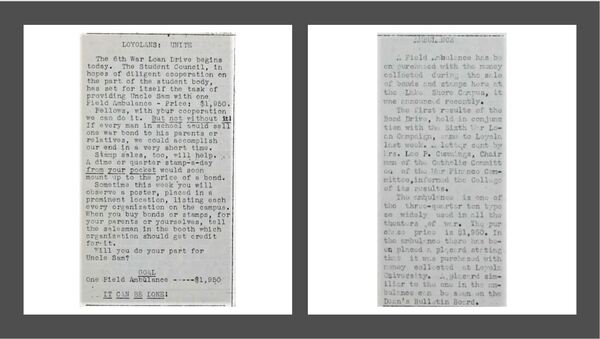
Two articles in the Loyola News describing the students' efforts to buy a field ambulance by selling war bonds.
-
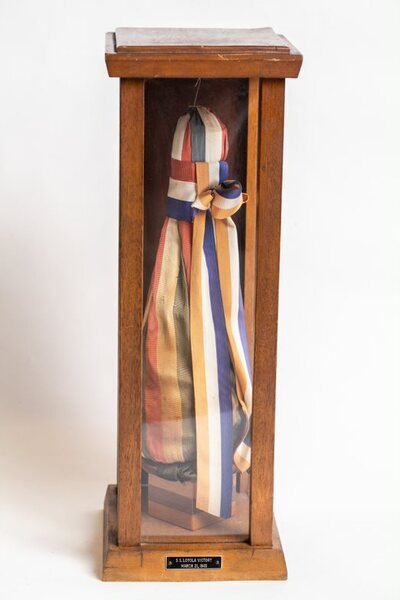
Color photo of the bottle used at the christening of the S.S. Loyola.
-
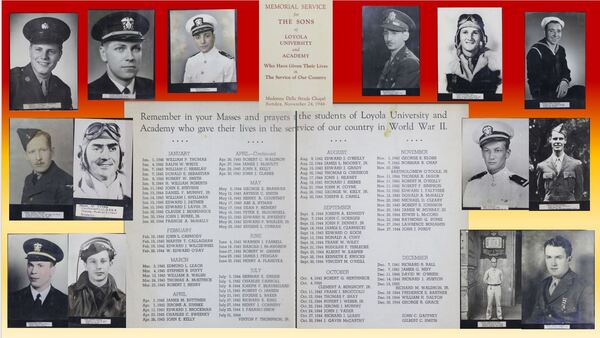
A collage:
Center: The memorial mass program held after the end of World War II.
Around center: Black-and-white photographs from the memorial scrapbook of former students who died while in the service during World War II.
-
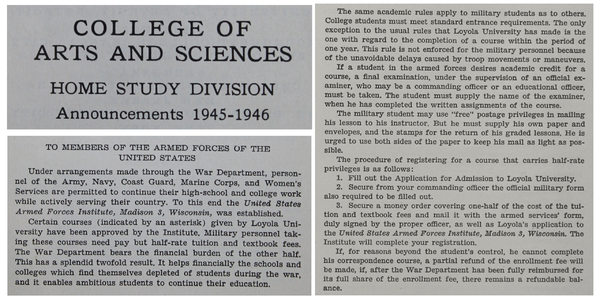
A collage of details from the cover and pages 13 and 14 of the Loyola University Chicago 1945-46 Home Study Division Bulletin.
Upper left: detail from cover page for the College of Arts and Sciences Home Study Division Bulletin
Lower left: detail of page 13, addressed to members of the armed forces of the United States, explaining special considerations for them to be able to participate in correspondence courses.
Right: detail from page 14, completing the section from page 13 and explaining the logistics of participating in the courses.
-
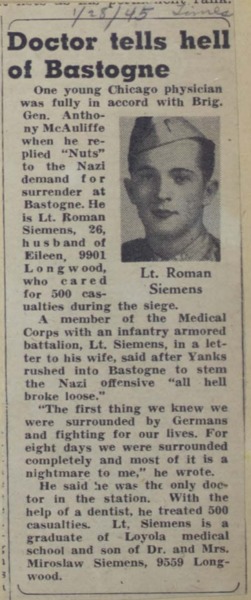
This news clipping appears on page 30 of the World War II scrapbook. The article describes the experiences of Lieutenant Roman Siemens, a graduate of the Loyola medical school and member of the Medical Corps with an infantry armored battalion, as quoted in a letter to his wife Eileen. He was the only doctor in the station when the Nazi offensive demanded the Americans surrender. He and a dentist treated 500 casualties.
"One young Chicago physician was fully in accord with Brig. Gen. Anthony McAuliffe when he replied "Nuts" to the Nazi demand for surrender at Bastogne. He is Lt. Roman Siemens, 26, husband of Eileen, 9901 Longwood, who cared for 500 casualties during the siege.
A member of the Medical Corps with an infantry armored battalion, Lt. Siemens, in a letter to his wife, said after Yanks rushed into Bastogne to stem the Nazi offensive "all hell broke loose."
"The first thing we knew we were surrounded by Germans and fighting for our lives. For eight days we were surrounded completely and most of it is a nightmare to me," he wrote.
He said he was the only doctor in the station. With the help of a dentist, he treated 500 casualties. Lt. Siemens is a graduate of Loyola medical school and son of Dr. and Mrs. Miroslaw Siemens, 9559 Longwood."
-

An article describes the new location of the 108th Army General Hospital, sponsored by Loyola University, at the Hospital Beaujou in Clichy, France.
"The 108th Army General Hospital, sponsored by Loyola University, is now located at The Hospital Beaujou in Clichy, France, two and one half miles outside of Paris, it was announced at the University on October 19th.
This Loyola-staffed hospital is reported to be the largest that the army has taken over anywhere in the world. It is eleven stories high, the top four floors being devoted entirely to operating rooms. It has the latest and best equipment and is receiving blood from the U.S. that is four days old.
The hospital's personnel, under the command of Lt. Col. William J. Vynalek, consists of 60 doctors and dentists from the Loyola University schools of Medicine and Dentistry, 115 nurses from Loyola affiliated hospitals, and 800 enlisted men, many of whom are former Loyola students. The Chaplain of the hospital is Capt. George L. Warth, S.J., former Loyola Medical School regent. He was one of the first Jesuits to go on active duty in World War II."
-
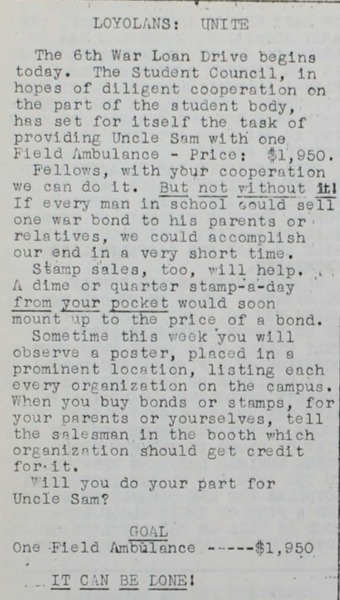
This article in the Loyola news calls on students to help sell war bonds to raise a total of $1,950 to fund a field ambulance in World War II.
-
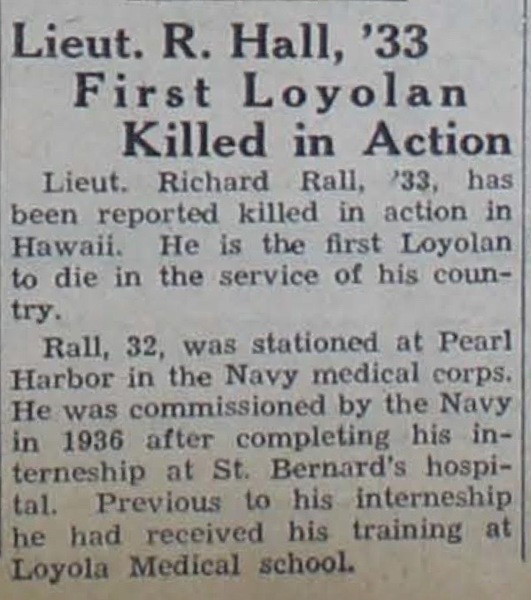
This short article reports the death in action of the first Loyolan (alumnus, student, faculty, or staff) to be killed in World War II. His name is given as "R. Hall" or "Richard Rall," possibly a typo.
"Lieut. Richard Rall, '33, has been reported killed in action in Hawaii. He is the first Loyolan to die in the service of his country.
Rall, 32, was stationed at Pearl Harbor in the Navy medical corps. He was commissioned by the Navy in 1936 after completing his interneship at St. Bernard's hospital. Previous to his interneship he had received his training at Loyola Medical school."
-
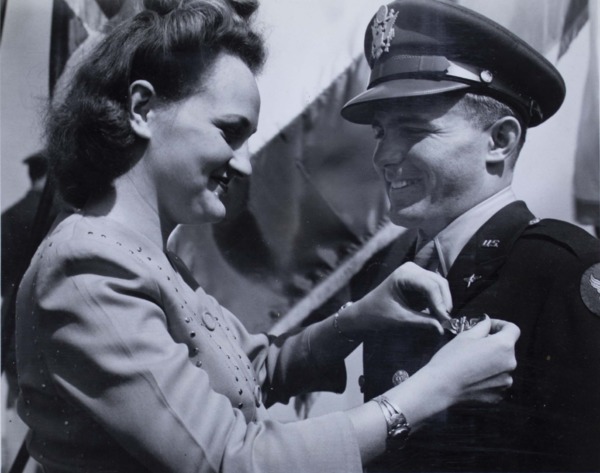
A woman attaches a pin with wings onto Lieutenant Joseph Kafka's uniform lapel. This photo appears on page 8 of the World War II scrapbook, and is labeled, "Lt. Joseph Kafka."
-
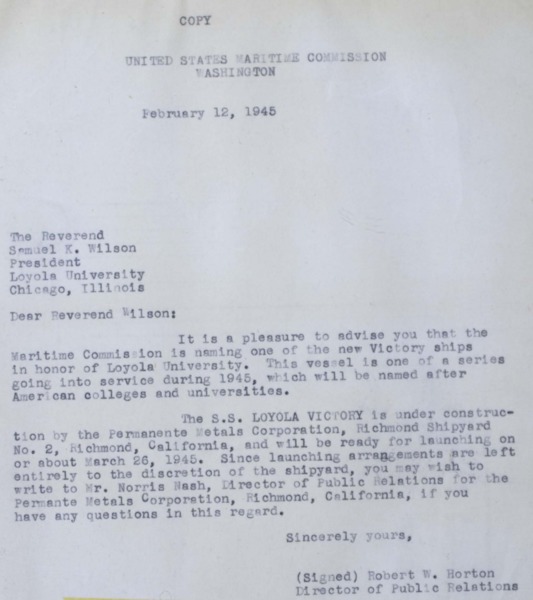
This letter, a copy of an original, is taped into the World War II scrapbook on page 7. Robert W. Horton, Director of Public Relations of the U.S. Maritime Commission, wrote to tell Rev. Wilson that a new battleship under construction had been named the S.S. Loyola Victory and would be launching in March, 1945.
-
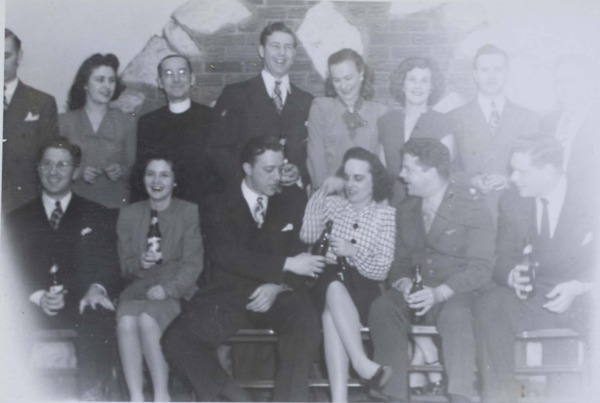
A group of students and attendees pose seated and standing during a party held in the student lounge during World War II. In the World War II scrapbook, this is one of several photos labeled "War Party - Students' Lounge."
-
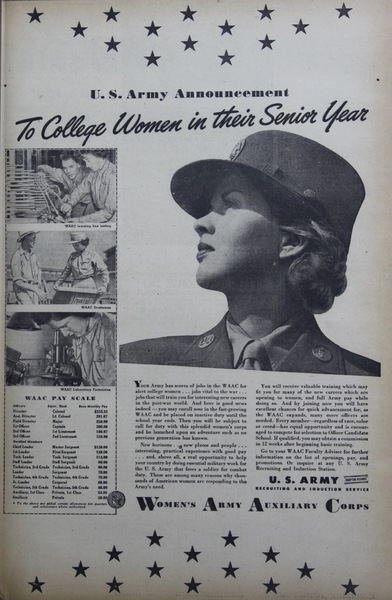
A full page ad depicts women working in the war effort during World War II. It is titled: "U.S. Army Announcement To College Women in their Senior Year." It was placed by the U.S. Army Recruiting and Induction Services for the Women's Army Auxiliary Corps (WAACs).
-

This article by Harry Pherson uses a tongue-in-cheek tone to cover the shortage of razor blades due to war rationing. Students began growing beards rather than shave.
-
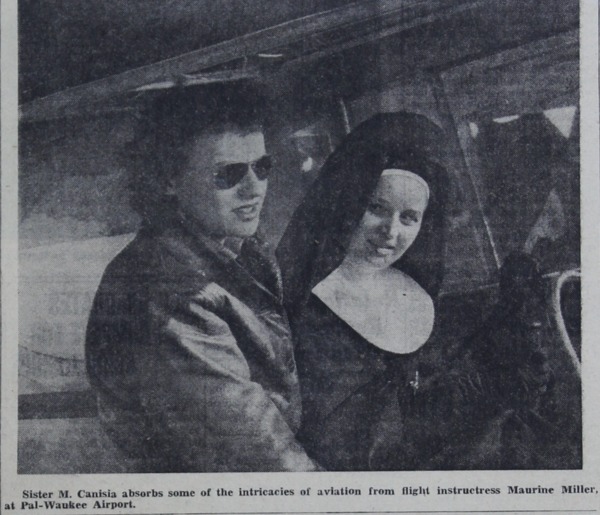
1) Sister M. Canisia Majewska (wearing a habit) and flight instructress Maurine Miller (wearing a leather jacket and sunglasses) sit in an airplane at Palwaukee Airport, later Chicago Executive Airport. This photo appears in the Loyola News.
2) Thirty nuns from Loyola's University College studying Aeronautics trained at Palwaukee Airport during World War II. They planned to teach pre-flight classes at Chicago Catholic high schools starting in the fall semester. Many were funded with scholarships from the Civil Aeronautics Authority.
-
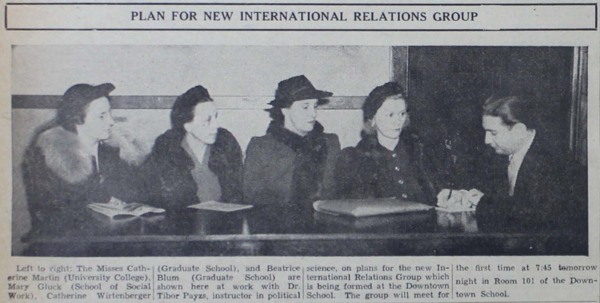
A group of Loyola students wearing fur coats and hats sit at a long table facing one person at the end who is writing something on a piece of paper.
This photo accompanies an article about the founding of the new International Relations group at Loyola. Each meeting, open to all students, would be led by a different student, beginning with Miss Beatrice Blum on the topic of "America's War Aims."
The caption reads:
"Left to right: The Misses Catherine Martin (University College), Mary Gluck (School of Social Work), Catherine Wirtenberger (Graduate School), and Beatrice Blum (Graduate School) are shown here at work with Dr. Tibor Payzs, instructor in political science, on plans for the new International Relataions Group which is being formed at the Downtown School. The group will meet for the first time at 7:45 tomorrow night in Room 101 of the Downtown School."
-
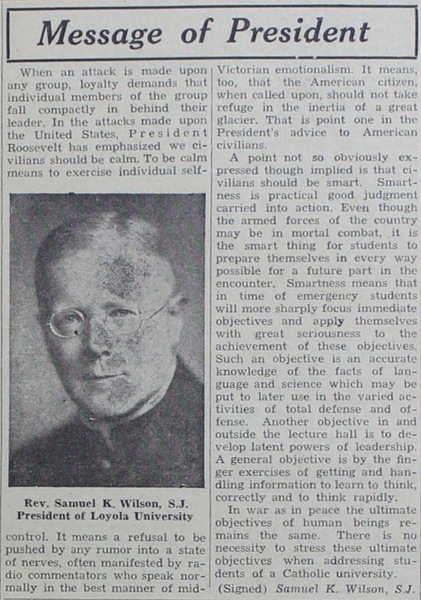
An article titled "Message of President" appears on the first page of the Loyola News on Dec. 15, 1941. Includes a photo of Rev. Samuel K. Wilson, S.J. President of Loyola University, and is signed by him as well.
In this piece, Rev. Wilson emphasizes loyalty when under attack, remaining calm, refusing "to be pushed by any rumor into a state of nerves," and that the American citizen had been called upon.
He also emphasizes smartness, and that "it is the smart thing for students to prepare themselves in every way possible for a future part in the encounter." School could prepare them with technical knowledge for defense and offense, "powers of leadership," and "to learn to think, correctly and to think rapidly."
-
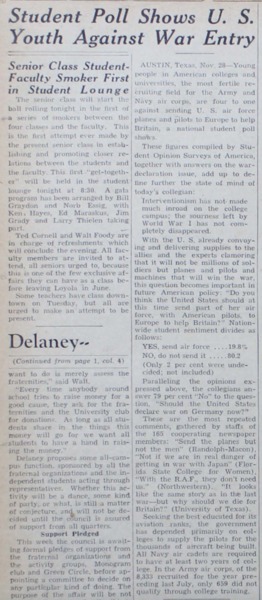
Image 1: Full article
Image 2: detail of title and first few paragraphs
This article discusses a national poll of American colleges and universities about whether the U.S. should sent pilots and planes to help Britain. The report states "Interventionism has not made much inroad on the college campus; the sourness left by World War I has not completely disappeared." 19.8% voted for to help Britain and 80.2% voted not to. To the question "Should the United States declare war on Germany now?" 79% answered "No." Some qualified their responses, hinting that the U.S. might need them "if ew are in real danger of getting in war with Japan." Another asked, "why should we die for Britain?"
Note that the bombing of Pearl Harbor occurred on December 7, 1941, only 5 days later.
-
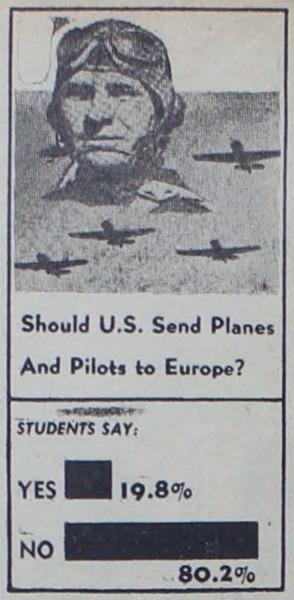
A graphic in the Loyola News depicts a pilot's face and a formation of planes. Below is the question, "Should U.S. Send Planes And Pilots to Europe?"
In the box below, titled, "Students Say:", Yes received 19.8% and No received 80.2%.
-
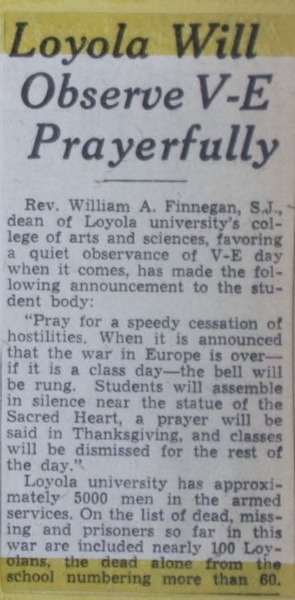
This news clipping appears on page 15 of the World War II scrapbook.
Titled "Loyola Will Observe V-E Prayerfully," the article continues.
"Rev. William A Finnegan, S.J., dean of Loyola univeristy's college of arts and sciences, favoring a quiet observance of V-E day when it comes, has made the following announcement to the student body:
'Pray for a speedy cessation of hostilities. When it is announced that the war in Europe is over--if it is a class day--the bell will be rung. Students will assemble in silence near the statue of the Sacred Heart, a prayer will be said in Thanksgiving, and classes will be dismissed for the rest of the day.'
Loyola university has approximately 5000 men in the armed services. On the lis tof dead, missing and prisoners so far in this war there are included nearly 100 Loyolans, the dead alone from the school numbering more than 60."
-
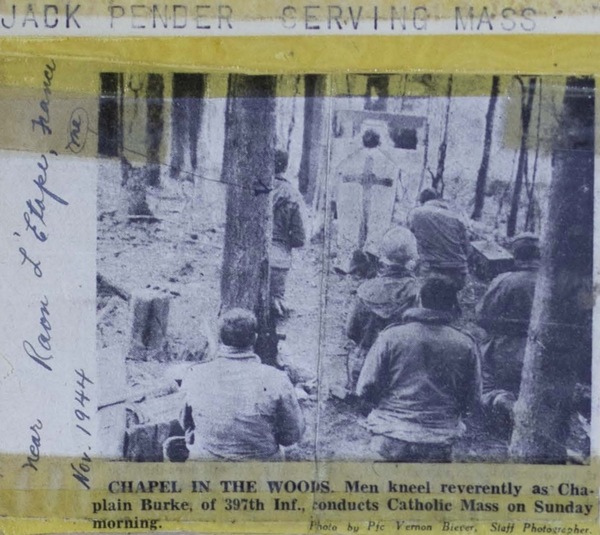
This news clipping appears on page 21 of the World War II scrapbook.
The image depicts a group of soldiers from behind, standing and kneeling, facing a makeshift altar among the trees of a forest.
The caption reads: "CHAPEL IN THE WOODS. Men kneel reverently as Chaplain Burke, of 397th Inf., conducts Catholic Mass on Sunday morning. Photo by Pfc Vernon Biever, Staff Photographer."
Above it is typed "JACK PENDER SERVING MASS" and on the left side in pen is written: "Near Raon L'Etape, France
Nov. 1944"
A small word "me" is circled and connected to an arrow pointing to a person standing just beyond a tree and facing the altar.
-
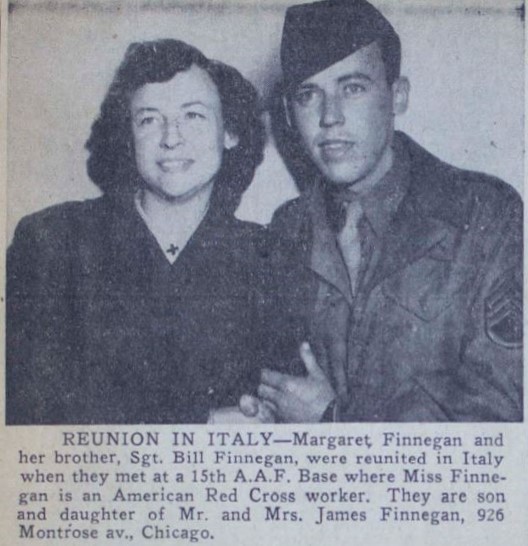
This photo and caption newspaper clipping appear in the World War II scrapbook. The photo depicts Margaret and Bill Finnegan, sister and brother.
"REUNION IN ITALY--Margaret Finnegan and her brother, Sgt. Bill Finnegan, were reunited in Italy where they met at a 15th A.A.F. Base where Miss Finnegan is an American Red Cross worker. They are son and daughter of Mr. and Mrs. James Finnegan, 926 Montrose av., Chicago."
-

This newspaper clipping appears in the World War II scrapbook on page 36.
An illustration of Hal Motz, Loyola alumnus and former basketball player on the school team, is accompanied by a stylized bio.
"Hal played three years of varsity basketball at Loyola University in Chicago, he was captain during his senior year and one of Loyola's greatest cagers.
After graduation he joined the famous Oshkosh All-Stars and became one of this colorful aggregations outstanding stars.
This six foot four inch - 230 pound giant will play for the Sheppard Field Team,
1st Lieutenant
Hal Motz"
By Charles E Straub, Lieutenant, Air Corps
Sheppard Fields, Texas

























